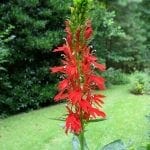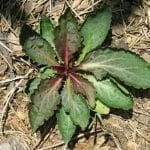- Flowers open from the bottom
- Winter rosette of leaves
- Hummingbirds adore cardinal flower
Scientific Name:
Cardinal flower (Lobelia cardinalis)
Common Name:
Cardinal flower (Lobelia cardinalis)
Scientific Name Pronounciation:
low-BEE-lee-uh kar-dih-NAL-iss
Plant Type:
Perennial
Plant Hardiness Zones:
3-10
Plant Hardiness Zone(s):
Usual Size:
1-3 ft. H X 1 ft. W
Flower:
Scarlet red flowers which cover the terminal 12 inches or so of the stalk; the flowers are tubular with two lips; the upper lip has two erect lobes, and the lower lip has three lobes that are spread out horizontally or dip downward; new flowers continue to develop at the tip of the lengthening stalk until frost.
Bloom Time Notes:
Summer
Leaf:
Winter leaves are a basal rosette of 5-7-inch-long, elliptical leaves which lie flat on the ground; in spring a stalk develops bearing smaller leaves.
Fruit:
A capsule filled with tiny seeds.
Wildlife:
Popular with hummingbirds and cloudless sulphur butterflies for nectar. Host plant for several butterflies and moths.
Natural Habitat:
Grows naturally in moist meadows, bogs, and along creeks and lakes, even into the edge of the water.
Propagation:
By seed or by separating offshoots from the basal rosettes during winter; will self-sow in favorable conditions.
Bloom Time:
Sun or Shade:
Companion Plants:
Cultural Notes:
Cardinal flower (Lobelia cardinalis) grows in full sun to partial shade; make sure that the basal rosette is not covered with leaves or other debris over the winter, as the plant depends on the winter sun and will decline and die if it cannot get it; not drought tolerant, but will tolerate average garden conditions.
The showy red flowers attract and are pollinated by hummingbirds; numerous named cultivars have flower colors ranging from red to white and with leaves ranging from red to purple.





